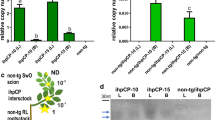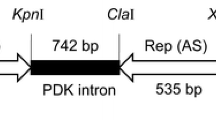Abstract
Necrosis disease incited by tobacco streak virus (TSV) causes significant yield losses in sunflower in the tropics and sub-tropics. Genetic engineering of sunflower through deployment of the coat protein gene of TSV (TSV-CP) was attempted along with neomycin phosphotransferase gene (nptII) for selection of putative transformants on kanamycin. Split cotyledons from decoated mature seeds were used as target tissues for Agrobacterium tumefaciens-mediated transformation and putative transformed shoots were obtained with an average frequency of 3.3%. Presence of the introduced transgene was identified by PCR; expression was determined through RT-PCR, northern blot analysis and quantitative Real-time PCR (qRT-PCR); stable integration was ascertained through Southern blot analysis of plants in T0 to T4 generations. Out of 102 positive T0 events, 20 events were carried to T1 generation from which five events (CP-S-237, CP-S-247, CP-S-481, CP-S-648 and CP-S-753) were advanced till T4 generation. Challenge inoculations of plants of event No 481 showed resistance to necrosis disease and plants grew to maturity in TSV-CP transgenics while control plants (untransformed) showed mortality within 1–2 weeks following inoculation. Expression analysis of the TSV-CP and nptII genes in different tissues at flowering and seed setting stages revealed constitutive expression of the transgene till seed maturation. One event (No 481) was selected for transfer of the TSV-CP gene into agronomically superior genotypes.








Similar content being viewed by others
Abbreviations
- BAP:
-
6-Benzylaminopurine
- CP-MR:
-
Coat protein-mediated resistance
- 2-iP:
-
N6-[2-Isopentenyl] adenine
- IAA:
-
Indole-3-acetic acid
- MS:
-
Murashige and Skoog
- NAA:
-
α-Naphthaleneacetic acid
- NptII:
-
Neomycin phosphotransferase gene
- PCR:
-
Polymerase chain reaction
- SND:
-
Sunflower necrosis disease
- TDZ:
-
1-Phenyl-3-(1,2,3-thiadiazol-5-yl) urea (thidiazuron)
- TSV:
-
Tobacco streak virus
References
Abel PP, Nelson RS, De B, Hoffmann N, Rogers SG, Fraley RT, Beachy RN (1986) Delay of disease development in transgenic plants that express the Tobacco mosaic virus coat protein gene. Science 232:738–743
Bag S, Singh RS, Jain RK (2007) Agrobacterium-mediated transformation of groundnut with coat protein gene of tobacco streak virus. Indian J Virol 18:65–69
Benzle KA, Finer KR, Marty D, McHale LK, Goodner BW, Taylor CG et al (2015) Isolation and characterization of novel Agrobacterium strains for soybean and sunflower transformation. Plant Cell Tiss Organ Cult 121:71–81
Bhat AI, Kumar A, Jain RK, Rao SC, Ramiah M (2001) Development of serological based assays for the diagnosis of sunflower necrosis disease. Ann Plant Prot Sci 9:292–296
Bhat AI, Jain RK, Kumar A, Ramiah M, Varma A (2002) Serological and coat protein sequence studies suggest that necrosis disease on sunflower in India caused by a strain of Tobacco streak ilarvirus. Arch Virol 147:651–658
Brunt AA, Crabtree K, Dallwitz MJ, Gibbs AJ, Watson L (1996) Viruses of plants: descriptions and lists from the VIDE database. CAB International, Wallingford
Chander Rao S, Prasada Rao RDVJ, Singh H, Hedge DM (2002) Information bulletin on sunflower necrosis disease and its management. Directorate of Oilseeds Research, Hyderabad
Chander Rao S, Bhatnagar Mathur P, Lava Kumar P, Sudarshan Reddy A, Sharma KK (2013) Pathogen-derived resistance using a viral nucleocapsid gene confers only partial non-durable protection in peanut against peanut bud necrosis virus. Arch Virol 158:133–143
Cornelissen BJC, Janssen H, Zuidema D, Bol JF (1984) Complete nucleotide sequence of tobacco streak virus RNA-3. Nucl Acids Res 12:2427–2437
Dasgupta I, Malathi VG, Mukherjee SK (2003) Genetic engineering for virus resistance. Curr Sci 84:341–354
Dijkstra J (1983) Tobacco streak virus in sunflower (Helianthus annuus). Neth J Plant Pathol 89:153–169
Doyle J, Doyle J (1990) Isolation of plant DNA from fresh tissue. Focus 12:13–15
Fagbenle HH, Ford RE (1970) Tobacco streak virus isolated from soybeans, Glycine max. Phytopathology 60:814–820
FAOSTAT (2016) http://www.fao.org/faostat/en/#data/QC. Accessed 15 Dec 2017
Fulton RW (1985) AAB descriptions of plant viruses: no. 307. Association of Applied Biologists, Wellesbourne
Jain RK, Bhat AI, Varma A (2003) Sunflower necrosis disease: an emerging viral problem. Technical Bulletin-1, Unit of Virology, IARI, New Delhi
Jain RK, Bag S, Awasthi LP (2005) First report of natural infection of Capsicum annuum by tobacco streak virus in India. Plant Pathol 54:257
Jain RK, Vemana K, Bag S (2006) Tobacco streak virus: an emerging virus in vegetable crops. In: Rao GP, Kumar PL, Holuguin-Pena RJ (eds) Characterization, diagnosis and management of plant viruses volume 3: vegetable and pulse crops. Studium Press LLC, Texas, pp 203–212
Kaiser WJ, Wyall SD, Pesho GR (1982) Natural hosts and vectors of Tobacco streak virus in eastern Washington. Phytopathology 72:1508–1512
Kung YJ, Bau HJ, Wu YL, Huang CH, Chen TM, Yeh SD (2009) Generation of transgenic papaya with double resistance to Papaya ringspot virus and Papaya leaf-distortion mosaic virus. Phytopathology 99:1312–1320
Lavanya N, Ramiah M, Sankaralingam A, Renukadevi P, Velazhahan R (2005) Identification of hosts for ilarvirus associated with sunflower necrosis disease. Acta Phytopathol Entomol Hung 40:31–34
Livak KJ, Schmittgen TD (2001) Analysis of relative gene expression data using real-time quantitative PCR and the 2(-Delta Delta C(T)) method. Methods 25:402–408
Mundembe R, Allison RF, Niang IS (2012) Genetic engineering of plants for resistance to viruses, genetic engineering: basics, new applications and responsibilities. In: Barrera-Saldaña HA (ed) Genetic engineering. InTech, Rijeka, pp 121–144
Murashige T, Skoog F (1962) A revised medium for rapid growth and bioassays with tobacco tissue cultures. Physiol Plant 15:473–497
Pradeep K, Satya VK, Selvapriya M, Vijayasamundeeswari A, Ladhalakshmi D, Paranidharan V, Rabindran R, Samiyappan R, Balasubramanian P, Velazhahan R (2012) Engineering resistance against Tobacco streak virus (TSV) in sunflower and tobacco using RNA interference. Biol Plant 56:735–741
Pramod K, Naganagouda A, Patil BV, Chandranath HT (2011) Evaluation of organic soil amendments for the management of sucking pests and necrosis disease sunflower. Plant Arch 11:403–408
Prasada Rao RDVJ, Reddy AS, Chander Rao S, Varaprasad KS, Thirumala Devi K, Nagaraju MV, Reddy DVR (2000) Tobacco streak virus as casual agent of sunflower necrosis disease in India. J Oilseeds Res 17:400–401
Prasada Rao RDVJ, Reddy AS, Reddy SV, Thirumala Devi K, Chander Rao S, Manoj Kumar V, Subramaniam K, Yellamanda Reddy T, Nigam SN, Reddy DVR (2003) The host range of tobacco streak virus in India and transmission by thrips. Ann Appl Biol 142:365–368
Prasada Rao RDVJ, Madhavi KJ, Reddy AS, Varaprasad KS, Nigam SN, Sharma KK, Kumar PL, Waliyar F (2009) Non-Transmission of Tobacco streak virus isolate occurring in India through the seeds of some crop and weed hosts. Indian J Plant Prot 37:92–96
Radonic LM, Lopez NE, Hopp E, Bilbao ML (2012) Analysis of T2 sunflower transgenic plants: high expression level and stability achieved by the rbcS1 promoter regulation. In: Proceedings of the 18th international sunflower conference, Mar del Plata
Ramiah M, Bhat AI, Jain RK, Pant RP, Ahlawat YS, Prabhakar K, Varma A (2001) Partial characterization of an isometric virus causing sunflower necrosis disease. Indian Phytopathol 54:246–250
Ravi KS, Buttgereitt A, Kitkaru AS, Deshmukh S, Lesemann DE, Winter S (2001) Sunflower necrosis disease from India is caused by an ilarvirus related to tobacco streak virus. Plant Pathol 50:800
Reddy AS, Prasada Rao RDVJ, Thirumala Devi K, Reddy SV, Mayo MA, Roberts I, Satyanarayana T, Subramaniam K, Reddy DVR (2002) Occurrence of tobacco streak virus on peanut (Arachis hypogaea) in India. Plant Dis 86:173–178
Reddy AS, Subramanyam K, Kumar PL, Waliyar F (2007) Assessment of tobacco streak virus (TSV) transmission through seed in groundnut and sunflower. J Mycol Plant Pathol 37:136–137
Reimann-Philipp U, Beachy RN (1993) Coat protein-mediated resistance in transgenic tobacco expressing the Tobacco mosaic virus coat protein from tissue specific promoters. Mol Plant-Microbe Interact 6:323–330
Sambrook J, Fritsch EF, Maniatis T (1989) Molecular cloning: a laboratory manual. Cold Spring Harbor Laboratory Press, New York
Sharman M, Thomas JE, Persley DM (2008) First report of Tobacco streak virus in sunflower (Helianthus annuus), cotton (Gossypium hirsutum), chickpea (Cicer arietinum) and mung bean (Vigna radiata) in Australia. Australas Plant Dis Notes 3:27–29
Shepherd DN, Mangwende T, Martin DP, Bezuidenhout M, Kloppers FJ, Carolissen CH, Monjane AL, Rybicki EP, Thomson JA (2007) Maize streak virus-resistant transgenic maize: a first for Africa. Plant Biotechnol J 5:759–767
Shirshikar SP (2003) Influence of different sowing dates on the incidence of sunflower necrosis disease. Helia 26:109–116
Singh H (2005) Thrips incidence and necrosis disease in sunflower. J Oilseeds Res 22:90–92
Srinivasan K, Mathivanan N (2009) Biological control of sunflower necrosis virus disease with powder and liquid formulations of plant growth promoting microbial consortia under field conditions. Biol Control 51:395–402
Sujatha M, Vijay S, Vasavi S, Veera Reddy P, Chander Rao S (2012) Agrobacterium-mediated transformation of cotyledons of mature seeds of multiple genotypes of sunflower (Helianthus annuus L.). Plant Cell Tissue Organ Cult 110:275–287
Varma A, Jain RK, Bhat AI (2002) Virus resistant transgenic plants for environmentally safe management of viral diseases. Indian J Biotechnol 1:73–86
Visser PB, Maagd RA, Jongsma MA (2007) Biotechnology in agriculture and forestry. Springer, Berlin
Zhu YJ, McCafferty H, Osterman G, Lim S, Agbayani R, Lehrer A, Schenck S, Komor E (2011) Genetic transformation with the untranslatable coat protein gene of sugarcane yellow leaf virus reduces virus titers in sugar cane. Transgenic Res 20:503–512
Acknowledgements
The authors thank the Director, ICAR-Indian Institute of Oilseeds Research, Hyderabad for providing necessary facilities for carrying out the work and Dr. K.K. Sharma, ICRISAT, Hyderabad for extending the facilities for Real-time PCR analysis.
Author information
Authors and Affiliations
Contributions
SV, SV, and TR assisted in the transformation work; MT helped in molecular analysis, RKJ provided the gene construct, SCR helped in virus challenge assays, KSV edited the manuscript, MS conceived and designed the research, analysed the results and prepared the manuscript. All authors read and approved the manuscript.
Corresponding author
Ethics declarations
Conflict of interest
The authors declare that they have no conflict of interest.
Additional information
Communicated by Yu-Jin Hao.
Electronic supplementary material
Below is the link to the electronic supplementary material.
Rights and permissions
About this article
Cite this article
Singareddy, V., Sheri, V.R., Muddanuru, T. et al. Genetic engineering of sunflower (Helianthus annuus L.) for resistance to necrosis disease through deployment of the TSV coat protein gene. Plant Cell Tiss Organ Cult 135, 263–277 (2018). https://doi.org/10.1007/s11240-018-1461-2
Received:
Accepted:
Published:
Issue Date:
DOI: https://doi.org/10.1007/s11240-018-1461-2




